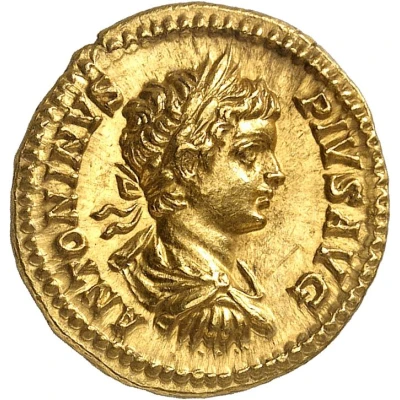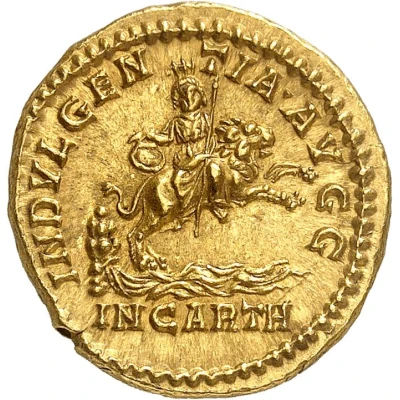Aureus - Caracalla LAETITIA TEMPORVM
| Gold | - | - |
| Issuer | Rome › Roman Empire (27 BC - 395 AD) |
|---|---|
| Emperor | Caracalla (Marcus Aurelius Antoninus Caracalla) (198-217) |
| Type | Standard circulation coin |
| Years | 201-210 |
| Value | 1 Aureus = 25 Denarii |
| Currency | Denarius, Reform of Augustus (27 BC – AD 215) |
| Composition | Gold |
| Shape | Round (irregular) |
| Technique | Hammered |
| Demonetized | Yes |
| Updated | 2024-10-05 |
| Numista | N#273205 |
|---|---|
| Rarity index | 100% |
Reverse
Ship, with mast and fittings, figures standing on deck, between four quadrigae, all racing left; to left, cock; to right, bear; below ship, from left to right, lion, two tigers, bull, and tiger.
Script: Latin
Lettering: LAETITIA TEMPORVM
Translation:
Laetitia temporum.
Joyous times.
Comment
Source:Online Coins of the Roman Empire (OCRE)
Interesting fact
The Aureus - Caracalla (LAETITIA TEMPORVM) coin was minted during the reign of Emperor Caracalla, who ruled the Roman Empire from 211 to 217 AD. The coin's obverse features an image of Caracalla wearing a radiate crown and a cuirass, while the reverse depicts the goddess Laetitia Temporum (Joy of the Times) standing left, holding a scepter and a small figure of Victory. The coin was made of gold, which was a valuable and prestigious metal at the time, and it was used as a means of exchange and a symbol of wealth and power. Interestingly, the coin's design was meant to convey a message of prosperity and happiness, as the name Laetitia Temporum suggests. The image of the goddess Laetitia was meant to represent the joy and prosperity that the Roman Empire was experiencing during Caracalla's reign. The coin's design was also meant to promote the idea of the Roman Empire as a powerful and prosperous state, with the image of Caracalla on the obverse serving as a symbol of the empire's strength and leadership. Overall, the Aureus - Caracalla (LAETITIA TEMPORVM) coin is a fascinating piece of history that provides insight into the culture, politics, and art of the Roman Empire during the 3rd century AD.

